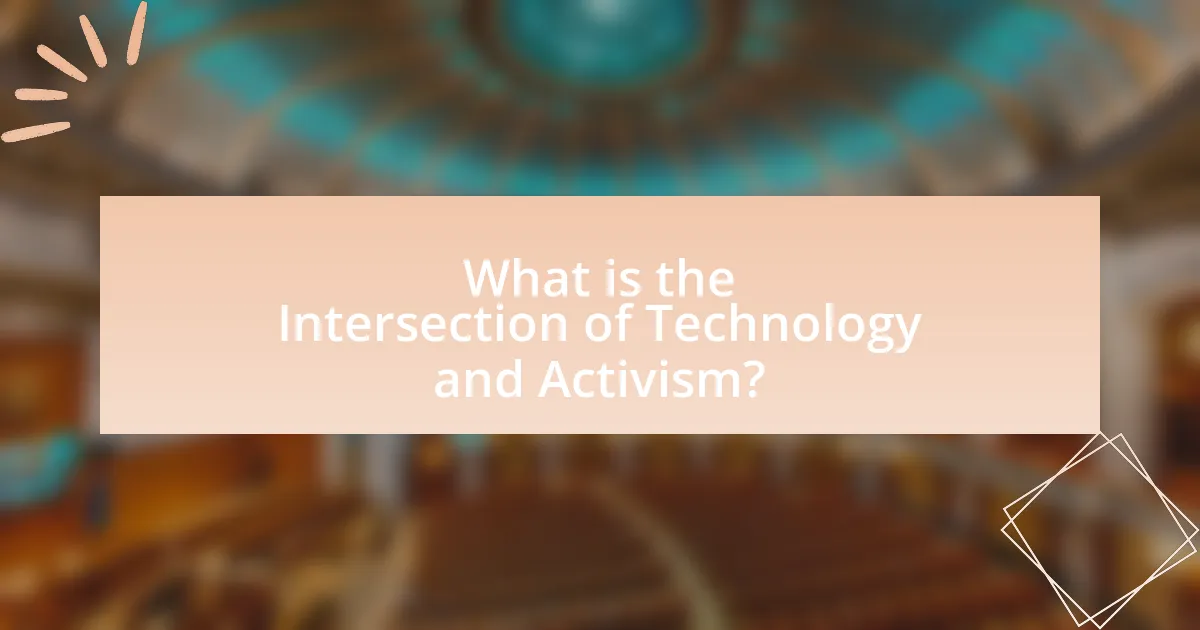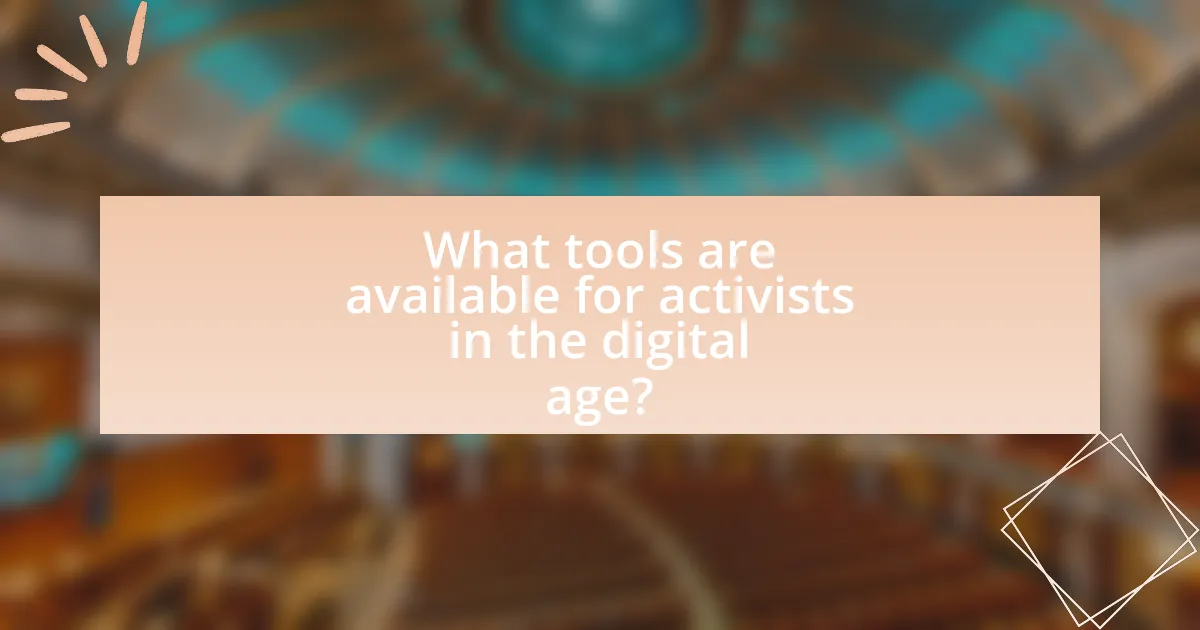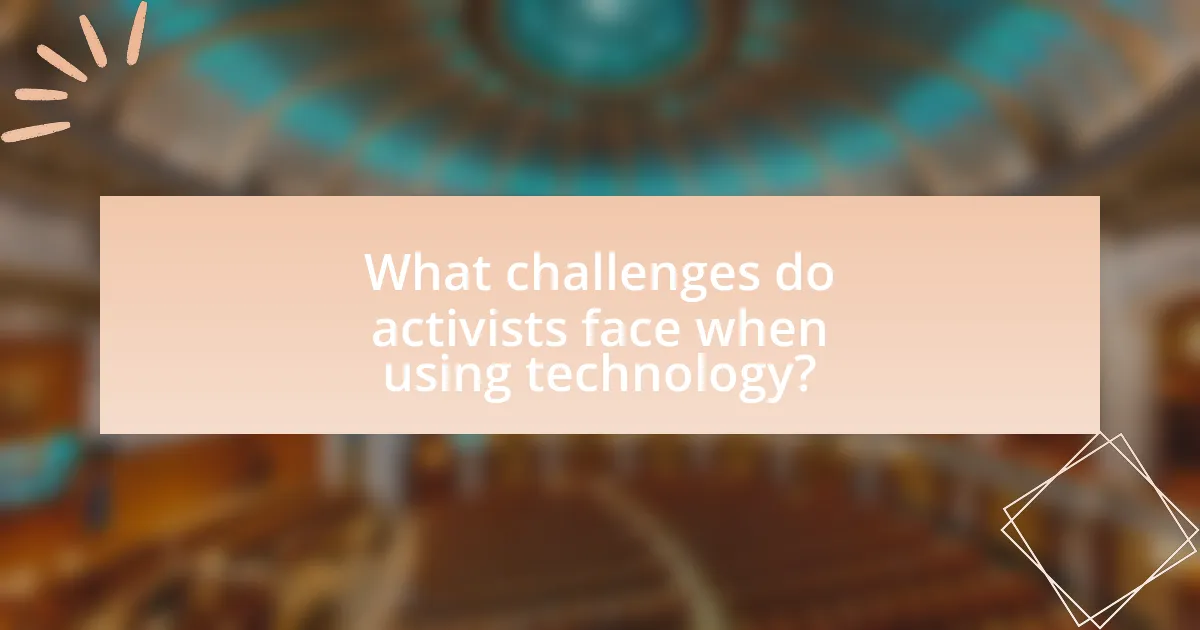The article explores the intersection of technology and activism, highlighting how digital tools and platforms facilitate social change and advocacy. It examines the influence of technology on modern activism, detailing key advancements such as social media, mobile technology, and data analytics that enhance communication and mobilization. The discussion includes the role of social media in organizing movements, the importance of online petitions, and the challenges activists face, including misinformation and digital security threats. Additionally, it outlines best practices for ethical digital activism and strategies for building digital literacy within communities, emphasizing the transformative potential of technology in driving social and political change.

What is the Intersection of Technology and Activism?
The intersection of technology and activism refers to the integration of digital tools and platforms to promote social change and advocacy. This relationship enables activists to mobilize support, disseminate information rapidly, and engage with a global audience. For instance, social media platforms like Twitter and Facebook have been pivotal in organizing movements such as the Arab Spring and Black Lives Matter, allowing for real-time communication and coordination among activists. Additionally, data analytics and online petitions have empowered grassroots organizations to amplify their messages and influence policy decisions effectively.
How has technology influenced modern activism?
Technology has significantly influenced modern activism by enhancing communication, mobilization, and awareness. Social media platforms like Twitter and Facebook allow activists to reach a global audience instantly, facilitating the rapid spread of information and organizing protests. For instance, the Arab Spring in 2011 demonstrated how social media could mobilize thousands of people in various countries, leading to significant political changes. Additionally, technology enables the use of crowdfunding platforms, which provide financial support for various causes, exemplified by campaigns like GoFundMe. Furthermore, data analytics and digital tools help activists track issues and measure the impact of their efforts, making activism more strategic and effective.
What are the key technological advancements that have shaped activism?
Key technological advancements that have shaped activism include the internet, social media platforms, mobile technology, and data analytics. The internet has provided a global stage for activists to share information and mobilize support, exemplified by movements like the Arab Spring, where online communication facilitated organization and awareness. Social media platforms such as Twitter and Facebook have enabled real-time communication and the viral spread of messages, significantly amplifying campaigns like #BlackLivesMatter. Mobile technology has allowed activists to document events and share live updates, as seen during protests where smartphones captured police actions. Data analytics has empowered organizations to analyze trends and target their efforts effectively, enhancing the impact of campaigns. These advancements collectively have transformed how activism is conducted, making it more accessible and impactful.
How do social media platforms facilitate activist movements?
Social media platforms facilitate activist movements by providing a space for rapid communication, organization, and mobilization of supporters. These platforms enable activists to share information, raise awareness, and coordinate actions in real-time, significantly amplifying their reach and impact. For instance, during the Arab Spring, social media was instrumental in organizing protests and disseminating information, leading to widespread political change across multiple countries. Additionally, studies show that social media campaigns can increase participation in movements; for example, the #BlackLivesMatter movement gained global traction through effective use of platforms like Twitter and Instagram, highlighting issues of racial injustice and mobilizing millions for protests.
Why is the intersection of technology and activism important?
The intersection of technology and activism is important because it enhances the ability of activists to mobilize, communicate, and effect change. Technology provides tools such as social media, which enables rapid dissemination of information and facilitates grassroots organizing. For instance, during the Arab Spring, social media platforms played a crucial role in coordinating protests and raising global awareness, demonstrating how technology can amplify activist voices and actions. This synergy not only increases the reach and impact of social movements but also fosters greater engagement and participation from diverse populations, ultimately driving social and political change.
What role does technology play in raising awareness for social issues?
Technology plays a crucial role in raising awareness for social issues by facilitating rapid information dissemination and enabling global connectivity. Social media platforms, for instance, allow activists to share messages and mobilize support instantly, reaching millions of users worldwide. According to a 2020 report by the Pew Research Center, 69% of adults in the U.S. use social media, which amplifies the visibility of social movements such as Black Lives Matter and climate change advocacy. Furthermore, technology enables the creation of online petitions and crowdfunding campaigns, which have proven effective in garnering support and funding for various causes. This interconnectedness and accessibility provided by technology significantly enhance the ability to raise awareness and drive social change.
How does technology empower marginalized communities?
Technology empowers marginalized communities by providing access to information, resources, and platforms for advocacy. For instance, mobile technology enables individuals in remote areas to connect with essential services, such as healthcare and education, which can significantly improve their quality of life. According to a report by the International Telecommunication Union, increased internet access has been linked to economic growth and social inclusion, particularly in developing regions. Furthermore, social media platforms allow marginalized voices to share their stories and mobilize support for social justice initiatives, exemplified by movements like #BlackLivesMatter, which gained global traction through online engagement. These technological advancements facilitate greater participation in civic life, enabling marginalized groups to advocate for their rights and influence policy changes effectively.

What tools are available for activists in the digital age?
Activists in the digital age have access to various tools that enhance their ability to organize, communicate, and mobilize. Social media platforms like Twitter and Facebook enable real-time communication and widespread dissemination of information, allowing activists to reach large audiences quickly. Additionally, encrypted messaging apps such as Signal and Telegram provide secure communication channels, protecting sensitive discussions from surveillance. Online petition platforms like Change.org facilitate grassroots mobilization by allowing individuals to rally support for causes. Crowdfunding websites, such as GoFundMe, enable activists to raise funds for their initiatives. Furthermore, data visualization tools like Tableau help activists present complex information in an accessible format, making their arguments more compelling. These tools collectively empower activists to drive social change effectively in a connected world.
What are the most effective digital tools for organizing protests?
The most effective digital tools for organizing protests include social media platforms, messaging apps, and event management software. Social media platforms like Twitter and Facebook enable rapid information dissemination and community engagement, allowing organizers to reach a broad audience quickly. Messaging apps such as WhatsApp and Signal facilitate secure communication among organizers and participants, ensuring coordination without the risk of surveillance. Event management software like Eventbrite or Meetup helps in planning logistics, managing RSVPs, and providing updates to attendees. These tools have been proven effective in various movements, such as the Arab Spring and Black Lives Matter, where digital organization played a crucial role in mobilizing participants and amplifying messages.
How do mobile apps enhance grassroots organizing?
Mobile apps enhance grassroots organizing by facilitating communication, coordination, and mobilization among community members. These applications enable real-time messaging, event planning, and resource sharing, which are crucial for effective grassroots movements. For instance, platforms like WhatsApp and Signal allow organizers to quickly disseminate information and updates, while apps like Eventbrite help in organizing rallies and meetings. Research indicates that grassroots movements utilizing mobile technology can increase participation rates by up to 50%, demonstrating the significant impact of these tools on community engagement and activism.
What online platforms are best for fundraising and support?
The best online platforms for fundraising and support include GoFundMe, Kickstarter, and Indiegogo. GoFundMe is widely recognized for personal fundraising and charitable causes, having raised over $9 billion since its inception in 2010. Kickstarter focuses on creative projects, allowing creators to raise funds through pre-orders, with over $5 billion pledged to projects since its launch in 2009. Indiegogo offers flexible funding options for various initiatives, including personal, creative, and entrepreneurial projects, and has facilitated over $1.5 billion in funding. These platforms are effective due to their user-friendly interfaces, extensive reach, and established trust within communities.
How can technology be used for advocacy and policy change?
Technology can be used for advocacy and policy change by facilitating communication, mobilizing communities, and providing data-driven insights. Digital platforms enable activists to reach a broader audience quickly, as seen in movements like the Arab Spring, where social media played a crucial role in organizing protests and disseminating information. Additionally, technology allows for the collection and analysis of data, which can support evidence-based policy recommendations, as demonstrated by organizations like DataKind, which uses data science to address social issues. These capabilities enhance the effectiveness of advocacy efforts and influence policymakers by presenting compelling, data-backed narratives.
What role do data analytics play in shaping public policy?
Data analytics play a crucial role in shaping public policy by providing evidence-based insights that inform decision-making processes. Policymakers utilize data analytics to identify trends, assess the impact of existing policies, and forecast potential outcomes of proposed initiatives. For instance, the use of data analytics in the analysis of crime statistics has led to more effective law enforcement strategies, as seen in cities like New York, where data-driven approaches have contributed to a significant reduction in crime rates. Furthermore, data analytics enables the evaluation of public health initiatives, such as tracking the spread of diseases, which was particularly evident during the COVID-19 pandemic when data was essential for guiding public health responses.
How can activists leverage online petitions for impact?
Activists can leverage online petitions to create significant impact by mobilizing public support and influencing decision-makers. Online petitions provide a platform for activists to gather signatures quickly, demonstrating widespread backing for a cause, which can attract media attention and pressure authorities to respond. For instance, the petition to ban single-use plastics in the European Union garnered over 1 million signatures, leading to legislative discussions. This illustrates how quantifiable support can translate into political action, making online petitions a powerful tool for advocacy and change.

What challenges do activists face when using technology?
Activists face significant challenges when using technology, including surveillance, misinformation, and digital security threats. Surveillance by governments and corporations can lead to the monitoring of activists’ online activities, which may deter participation and compromise safety. Misinformation can undermine campaigns, as false narratives spread rapidly on social media, confusing the public and diluting the activists’ messages. Additionally, digital security threats, such as hacking and data breaches, expose sensitive information and can jeopardize the safety of activists and their networks. These challenges highlight the complex landscape activists navigate in leveraging technology for social change.
What are the risks associated with digital activism?
Digital activism carries several risks, including surveillance, misinformation, and backlash from authorities. Activists often face increased scrutiny from governments and corporations, leading to potential legal repercussions or harassment. For instance, a report by the Electronic Frontier Foundation highlights that digital activists can be tracked through their online activities, making them vulnerable to state-sponsored repression. Additionally, misinformation can spread rapidly on social media platforms, undermining the credibility of movements and causing confusion among supporters. The 2016 U.S. presidential election serves as a notable example, where misinformation campaigns significantly impacted public perception and trust in various movements. Lastly, backlash from authorities can manifest in the form of arrests or censorship, as seen in countries with strict internet regulations, where activists are often targeted for their online expressions.
How can activists protect their privacy and security online?
Activists can protect their privacy and security online by utilizing strong encryption tools, employing secure communication platforms, and practicing good digital hygiene. Strong encryption tools, such as Signal for messaging and ProtonMail for email, ensure that communications remain confidential and inaccessible to unauthorized parties. Secure communication platforms provide end-to-end encryption, which is crucial for safeguarding sensitive information. Additionally, practicing good digital hygiene, such as regularly updating software, using strong, unique passwords, and enabling two-factor authentication, further enhances online security. According to a report by the Electronic Frontier Foundation, using these practices significantly reduces the risk of surveillance and data breaches, thereby protecting activists’ identities and activities.
What are the implications of misinformation in digital activism?
Misinformation in digital activism can significantly undermine the credibility and effectiveness of social movements. When activists disseminate false information, it can lead to public distrust, divert attention from legitimate issues, and create confusion among supporters. For instance, a study by the Pew Research Center found that 64% of Americans believe misinformation has a major impact on public opinion, which can hinder collective action and weaken advocacy efforts. Additionally, misinformation can provoke backlash from opposing groups, further polarizing communities and complicating dialogue. This dynamic illustrates how the spread of false narratives can derail the goals of digital activism, making it crucial for activists to prioritize accurate information.
How can activists overcome technological barriers?
Activists can overcome technological barriers by leveraging accessible digital tools and fostering community collaboration. For instance, utilizing social media platforms allows activists to disseminate information widely and mobilize support quickly, as evidenced by the success of movements like the Arab Spring, where platforms like Twitter and Facebook played crucial roles in organizing protests. Additionally, training programs that enhance digital literacy among activists can empower them to navigate and utilize technology effectively, thereby reducing the impact of technological barriers.
What strategies can be employed to ensure digital inclusivity?
To ensure digital inclusivity, organizations can implement strategies such as providing accessible technology, offering digital literacy training, and fostering community engagement. Accessible technology includes designing websites and applications that comply with accessibility standards, ensuring that individuals with disabilities can navigate digital spaces effectively. Digital literacy training equips marginalized groups with the skills needed to use technology confidently, which is essential as research indicates that 15% of the global population lives with some form of disability, highlighting the need for tailored training programs. Community engagement involves collaborating with local organizations to understand the specific needs of diverse populations, thereby creating solutions that are relevant and effective. These strategies collectively contribute to a more inclusive digital environment, enabling broader participation in the digital economy and society.
How can activists build digital literacy within their communities?
Activists can build digital literacy within their communities by organizing workshops and training sessions focused on essential digital skills. These initiatives can include teaching community members how to use the internet safely, navigate social media platforms, and access online resources for advocacy. For instance, a study by the Pew Research Center found that 73% of adults believe that digital skills are essential for success in today’s job market, highlighting the importance of these skills in empowering individuals. By providing hands-on training and resources, activists can enhance community members’ confidence and ability to engage with technology effectively.
What best practices should activists follow when using technology?
Activists should prioritize digital security, transparency, and effective communication when using technology. Digital security practices include using strong passwords, enabling two-factor authentication, and employing encrypted messaging apps to protect sensitive information. Transparency involves sharing information responsibly and ensuring that data is accurate and verifiable, which builds trust within communities and among supporters. Effective communication entails utilizing social media platforms strategically to engage audiences, mobilize support, and raise awareness about causes. According to a report by the Electronic Frontier Foundation, implementing these practices can significantly reduce risks associated with online activism and enhance the overall impact of advocacy efforts.
How can activists effectively engage their audience online?
Activists can effectively engage their audience online by utilizing targeted social media strategies, creating compelling content, and fostering community interaction. Targeted social media strategies involve identifying the right platforms where their audience is most active, such as Instagram for younger demographics or Facebook for broader age groups. Compelling content, including videos, infographics, and personal stories, captures attention and encourages sharing, which can amplify their message. Fostering community interaction through live Q&A sessions, polls, and discussions builds a sense of belonging and encourages active participation. Research indicates that campaigns utilizing these methods can increase engagement rates by up to 50%, demonstrating their effectiveness in reaching and mobilizing audiences.
What are the key considerations for ethical digital activism?
Key considerations for ethical digital activism include transparency, accountability, and respect for privacy. Transparency ensures that activists clearly communicate their goals, methods, and funding sources, fostering trust among supporters and the public. Accountability involves taking responsibility for the impact of digital actions, including potential harm to individuals or communities. Respect for privacy is crucial, as activists must protect the identities and data of participants, especially in sensitive contexts. These considerations are supported by the principles outlined in the “Digital Activism Research Project,” which emphasizes the importance of ethical standards in online movements to prevent misuse of information and to promote responsible engagement.